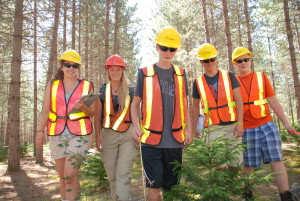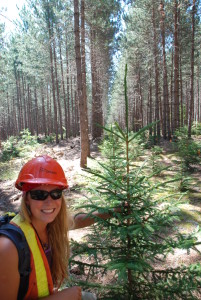Science of Trees – Trout Creek
Science of the Trees – Non Fiction – Invaluable
Fiction – A Wonderland Place – Pay Attention to the Details
Gurd and Bonner
Do Not Abandon – Values in Jeopardy
by Back Roads Bill
There are two destinations that are very enjoyable places to walk, in any season with lots of visual appeal; both are an oasis of calm and solitude much like, in some respects, Alice’s ‘Wonderland.’
One is called Gurd and the other is Bonner and the two are not part of a comedy team or to be confused, contextually, with the twins, Tweedledee and Tweedledum. They may look like identical and orderly tree farms but these are two, invaluable but different areas of scientific interest found on our back roads near Trout Creek and Moonbeam.
The importance of the sites from a “silvicultural” perspective cannot be understated (this word most often does not show up in the spell checker, try it). Silviculture is the practice of controlling the establishment, growth, composition, health, and quality of forests to meet diverse needs and values. The name comes from the Latin silvi- (forest) + culture (as in growing). The amount of tree study has a longitudinal value, which does not exist at many locations on the research landscape.
Values in Jeopardy?
John Pineau, is Ontario’s lead for FP (Forest Products) Innovations. The not-for-profit world leader specializes in the creation of scientific solutions in support of the Canadian forest sector. He recognizes the value of these designated areas. “The Gurd Research Area comprises a significant legacy of excellence in long-term forest science and research within the Great Lakes Forest Region. Since its establishment in 1963 there have been more than 20 individual projects – mainly a variety of growing tests and trials in which white and red pine species have figured prominently.
“I am very proud of the work that was accomplished during the time of the Forestry Research Partnership (FRP) from 2000 to 2012, when we helped to re-measure and collect data on a number of older studies, and established several new trials including a jack pine competition study, and a white pine progeny test. We also undertook some interpretive and technology transfer work so that the results of the many Gurd studies were well communicated to forest professionals and practitioners.” The FRP was comprised of Tembec, the Ministry of Natural Resources and Forestry, Natural Resources Canada and the Canadian Ecology Centre; it is no more.
He explained the timeliness of Gurd. “Unfortunately the investment in and maintenance of Gurd has been hit and miss over five decades. I hope that there is some renewed effort to ensure a permanent level of funding,” said Mr. Pineau. “It would not take much to maintain the research and science, and to continue to promote knowledge exchange so that we better inform our forest management decision making, and ultimately the sustainability of what we do in the forest.”
Al Stinson, a forester, is the most recent Past President of the Canadian Institute of Forestry. He said, “The value of these properties is the legacy of research that they represent back to the early 1960’s and the archive of genetic material they represent. For example at Gurd there is a clonal seed orchard that has poplar plus trees from two townships near Chapleau, the poplar are long gone from these townships as the material was collected in the early 60’s, similarly there is a Red Pine clonal seed orchard with genetic material from, plus trees where the original collections were done in the late 1950’s, again the Red Pine are long gone from the townships around Temagami where they were collected. But the genetic material still exits at places like Gurd and Bonner in the form of clonal seed orchards. They also have a very important educational value for both the public at large and forest practitioners.”
This Summer
As an update for Gurd, Marinus Verwey, Resource Management Technician, North Bay – District Office, Ministry of Natural Resources and Forestry (MNRF) said, “Most of the research and maintenance work in the research area is carried out by MNRF staff, with some assistance from the forest industry.”
The Gurd Research Area is the host of a number of research projects that are ongoing and one of a few tree seed orchards in the area that produce seeds for both North Bay and Temagami. Some of the active research plots within the research area are utilized by the Biodiversity and Monitoring Section (BAMS) of the MNRF such as conifer (red pine and white spruce) thinning trials and in hardwood selection. The Gurd Research Area continues to be an active and important research area for the provincial Growth and Yield Program run by BAMS. There is also a
growth and yield study of harvesting regimes in red pine, white spruce, and tolerant hardwood forest conditions as well as a white pine genetic progeny test.”
Shannon Page is Partnership Specialist with MNRF she explained data collection undertaken. “There are a few research projects existing in the Gurd Research Area. One of these is the monitoring of the growth and health of red spruce seedlings planted under a red pine canopy,” she said. “The North Bay District Stewardship Youth Rangers (SYR) crew was recently involved in this monitoring. Throughout the summer SYR crews work with partners who benefit from assistance in completing and showcasing their projects as well as sharing their knowledge and skills with rangers. The SYR crew was involved in measuring the height and presence or absence (mortality) of the red spruce seedlings that were planted under a red pine nursery crop. Data collected will help to verify the competitive growth of red spruce in various shade concentrations.”
“Tree-t Yourself”
The Edward Bonner Tree Improvement Centre, within the boreal forest, is located just east of Moonbeam.. That’s the small town near Kapuskasing with the iconic spaceship; stop for a “selfie,” but it really looks best at night. Drive three kilometres east from the spaceship; then turn north on Nursery Rd. and drive the short distance to a ‘T’ intersection; turn west (left), proceed to the dead end ( WGS 84 17 U E418235 N5470919 or N49° 23.128’ W82° 07.597’; you are on the 49th parallel). The Bonner site was originally a potato farm and was established in 1948. Covering 503 hectares, it is named after Edward Bonner, a former Chief Forester of Spruce Falls Power and Paper Co. A series of white spruce plantations dating from 1961 contain some intensively managed and thinned sections that provide for interesting comparison. In general the density-managed trees have a much greater volume than those trees of the same age. This indicates the need to manually tend or use a chemical agent to knock back the competition. The bonus here is to stay within the area or nearby Rene Brunelle Provincial Park. The best way is take your bike it’s amazing! The park and Moonbeam are connected with an extensive asphalted trail system (the ‘Main’ trail is 11 km); a bike path not found anywhere else in rural Northern Ontario. There is another 28 km of cross country, snowshoe and walking trails including the ‘Nursery’ and ‘Bonner’ loops. See http://naturetrails.moonbeam.ca map for the big picture.
Gurd is closer to home, drive west of Trout Creek, 7.6 km, on Highway 522, turn north or right on Black Creek Rd. and drive 2.6 km into the 200 hectare site (WGS 84 17 T E619341 N5093219 or N45° 58.930’ W79° 27.556’). It was another abandoned tract of farming land of “broken promises and shattered dreams” – pick up a handful of soil, it is aptly described as coarse to silty fine sands, good for growing conifers not crops. There is something different about walking down these orderly rows of trees maybe it is respite from the usual “bushwhacking,” (“It’s just over there…”). In 1964 it was the province’s most important seed orchard. From the most recent, 2008 comprehensive report it states, “The challenge here and at Bonner that many of the scientific trials were under the direction of the province’s staff and have had to survive through ongoing staff changes and policy mandates.” This affects the continuity of funding, data collection and maintenance of the many “living” studies. The report recommends the deployment of personnel and “regular funding.”
There is a couplet within a Bob Dylan song, ‘Tweedle Dee &Tweedle Dum,’ “…They walk among the stately trees. They know the secrets of the breeze…” Walking through Gurd and Bonner is different though, it takes one through regimented trees alright, and whose appearance is ever-changing with colour variations of species and amount daylight filtering through the crowns. To “see the forest through the trees” is an ageless idiom that means to be able to discern an overall pattern (the big picture again) from a mass of detail. Maybe we need to pay attention to these natural heritage details so we don’t lose the research value and take on a similar reputation garnered by the two fictional characters found in Lewis Carroll’s ‘Through the Looking-Glass, and What Alice Found There,’ another wonderland, (the sequel). Be like Alice and make it a fantastical excursion with these “stately” trees.


